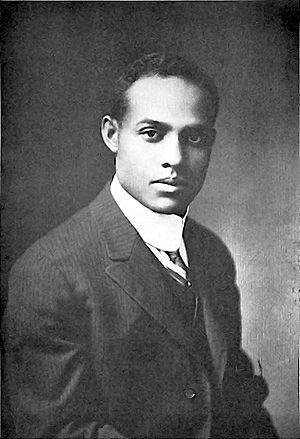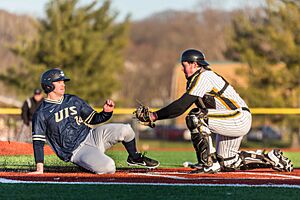West Virginia State University facts for kids
 |
|
|
Former names
|
West Virginia Colored Institute (1891–1915) West Virginia Collegiate Institute (1915–1929) West Virginia State College (1929–2004) |
|---|---|
| Motto | Veritas Lux Mundi (Latin) |
|
Motto in English
|
"Truth is the Light of the World" |
| Type | Public historically black land-grant university |
| Established | 1891 |
| Accreditation | HLC |
|
Academic affiliations
|
|
| Endowment | $12.6 million (2021) |
| President | Ericke S. Cage |
| Students | 3,879 (fall 2017) |
| Undergraduates | 3,755 |
| Postgraduates | 124 |
| Location |
,
,
United States
38°22′57″N 81°45′56″W / 38.38250°N 81.76556°W |
| Campus | Midsize suburb, 100 acres (0.40 km2) |
| Newspaper | The Yellow Jacket |
| Colors | Black and gold |
| Nickname | Yellow Jackets |
|
Sporting affiliations
|
NCAA Division II - MEC |
| Mascot | Stinger |
 |
|
West Virginia State University (WVSU) is a public university in Institute, West Virginia. It was founded in 1891 as the West Virginia Colored Institute. It is one of the original 19 "land-grant" colleges. These schools were created to provide education, especially in farming and mechanical arts, to African American students. Over time, WVSU became a very diverse campus. By 2017, most of its students were white, with about 8% being African-American.
The university has a special part called the Gus R. Douglass Land-Grant Institute. This institute helps communities and farmers across West Virginia. It offers programs for young people, helps with farming and natural resources, and supports local businesses. It also does research on things like growing plants and protecting the environment. Another important part is CASTEM, which encourages young people to study STEM subjects. This helps them become engineers, scientists, and leaders.
Contents
University History
WVSU is built on land that was once home to Native Americans. Later, this land was owned by George Washington. It was then sold and used as a farm where enslaved people were forced to work. In 1853, a man named Samuel I. Cabell bought the property. He worked hard to make sure his wife, Mary Barnes, and their children, who had been enslaved, would be free and inherit his property. He officially freed them in 1858.
After the American Civil War, Samuel Cabell was murdered. Years later, his daughter, Maria Cabell-Hurt, sold some of the land to the state. This allowed the West Virginia Colored Institute to be built. This was important because Black families in the area had to send their children to Ohio for higher education. Samuel and Mary Cabell and their children are buried on the campus.
Early Years and Growth
The school started as the West Virginia Colored Institute in 1891. It was part of a national effort to create colleges for Black students in states with segregated schools. The institute opened in May 1892 with over 40 students. Early classes included farming, mechanical skills, and home economics. In 1893, they added courses to train teachers. Military education also became a key part of the school.

In 1909, Booker T. Washington, a famous educator, suggested Byrd Prillerman as the school's president. Washington often visited the campus and spoke at its first graduation. During Prillerman's time, the school became a center for Black thinkers in West Virginia.
From 1891 to 1915, the school offered high school-level education. It also provided job training and prepared teachers for segregated schools. In 1915, its name changed to the West Virginia Collegiate Institute, and it began offering college degrees. In 1919, John Warren Davis became president. He hired excellent teachers and improved the courses. He even got the famous historian Carter G. Woodson to help as academic dean.
In 1927, the school earned a special approval from the North Central Association of Colleges and Schools. This made it the first of the original Black land-grant schools to get this important recognition. In 1929, the name changed again to West Virginia State College. It had about 1,000 students and many different study areas.
In 1939, West Virginia State College was one of the first Black colleges to offer an aviation program. This program helped train many African-American pilots for the U.S. Army Air Corps during World War II. Some of these pilots joined the famous Tuskegee Airmen. One graduate, Rose Agnes Rolls Cousins, was the first African-American woman to fly solo in the Civilian Pilot Training Program. During World War II, the college also participated in a Navy training program. In 1942, an ROTC program was started. Many graduates from WVSU's ROTC program have become high-ranking military officers.
Becoming Integrated
In 1954, a big change happened at West Virginia State College. After the Brown v. Board of Education ruling, which said that segregated schools were illegal, the college decided to welcome students of all races. This was a major step and made the college famous across the country. President William J. L. Wallace called it "a tribute to the character and courage of the people of Kanawha Valley." Because of this, West Virginia State adopted the motto "A Living Laboratory of Human Relations." Many more students enrolled after this change.
In 1957, the school lost its "land-grant" status for a while. This meant it lost some federal funding. But under President Hazo W. Carter, Jr., a long effort began to get this status back. In 1991, West Virginia recognized the school's land-grant status again. Then, in 2001, the U.S. Congress fully restored its land-grant status. This brought back important funding for teaching, research, and public service.
University Status Today
In 2003, the school's community college part became a separate school, but they still shared the same campus. In 2008, the community college fully separated and later moved to a different location.
In 2004, West Virginia State College officially became West Virginia State University. It started offering advanced degrees, like master's degrees, in subjects like Biotechnology and Media Studies. Later, it added graduate degrees in Law Enforcement and Education. The university aims to be a top research and teaching university in West Virginia.
University Leaders
Ericke S. Cage is the current president of West Virginia State University, starting in 2022. Many buildings on campus are named after past presidents who helped the university grow. For example, James Edwin Campbell was a poet and the first president. John Warren Davis was the longest-serving president, for 34 years. He focused on hiring great teachers and improving courses. William James Lord Wallace led the university through its important desegregation period. Dr. Hazo W. Carter, Jr. worked for 12 years to get the university's land-grant status back and helped it become a university.
Student Activities
Sports Teams

The sports teams at WVSU are called the Yellow Jackets. They compete in NCAA Division II. Men's sports include football, baseball, basketball, golf, and tennis. Women's sports include basketball, golf, softball, tennis, volleyball, and soccer.
In the past, when schools were segregated, WVSU played against other Black schools. After desegregation, the school joined a different conference. Today, WVSU is part of the Mountain East Conference. Their main rivals include the University of Charleston (WV), Central State University (OH), and Kentucky State University.
Music Programs
WVSU has a Music Department that offers degrees in music education and performance. Students can also get a music minor.
Instrumental Groups
The Yellow Jacket Marching Band, also known as the "Marching Swarm," performs at home football games and parades. They are known for their unique "corps-style" marching. The band has performed at many events, including the Veteran's Day Parade in Welch, WV.
The Wind Ensemble performs at graduation ceremonies and other concerts. WVSU also has a chamber orchestra called the West Virginia State Philharmonic Orchestra (WVSPO). This orchestra has performed at famous venues like Carnegie Hall in New York City and the Kennedy Center in Washington, D.C.
The Jazz Ensemble performs for various events on and off campus. They have traveled to Austria and performed for Emancipation Day celebrations in Washington, D.C.
Other instrumental groups include a Brass Ensemble, Guitar Ensemble, Percussion Ensemble, and Woodwind Ensemble. The Montclaire String Quartet, made up of musicians from the West Virginia Symphony Orchestra, is also based at WVSU.
Singing Groups
WVSU has a concert choir called the State A Capella. There is also an audition-only group called the State Singers. The State Singers often perform off campus and go on tour each spring. They have sung with the West Virginia Symphony Orchestra for holiday concerts and other special performances.
Student Life
Many students who live on campus come from different areas, both big cities and rural parts of West Virginia. They often gather at the Wilson Student Union.
Student News
WVSU has its own radio station, 106.7 FM, which plays music and interviews artists. The campus newspaper, The Yellow Jacket, is written and edited by students. You can find copies in buildings around campus.
Notable Alumni
- Chu Berry, a famous jazz tenor saxophonist.
- Joan Browning, a civil rights activist.
- Katherine Johnson, an African-American scientist who made important contributions to NASA's space missions. A statue of her is on campus, and a scholarship is named in her honor.
- Earl Lloyd, the first African-American to play in the NBA. A statue of him is in the Walker Convocation Center, and a basketball event, the Earl Lloyd Classic, is held in his honor.
- Lou Myers, an actor who played Vernon Gaines in the TV show A Different World.
- Bill Nunn, a journalist and professional football scout.
- Charles Calvin Rogers, a retired US Army major general and Medal of Honor recipient.
- Wendell Smith, an African-American sportswriter who helped Jackie Robinson become the first African-American player in Major League Baseball.
- Leon Sullivan, a civil rights leader and social activist. A building on campus, Sullivan Hall, is named after him.
- Carter G. Woodson, an African-American historian known as the "father of black history." He served as Academic Dean at WVSU.
See also
- List of presidents of West Virginia State University
- Storer College

